Nr 283 week 5 - Study guides, Class notes & Summaries
Looking for the best study guides, study notes and summaries about Nr 283 week 5? On this page you'll find 47 study documents about Nr 283 week 5.
Page 4 out of 47 results
Sort by
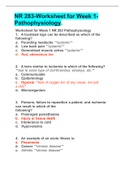
-
NR 283-Worksheet for Week 1- Pathophysiology Q&A Already Graded A
- Exam (elaborations) • 5 pages • 2023
-
- $5.69
- + learn more
NR 283-Worksheet for Week 1- Pathophysiology. Worksheet for Week 1 NR 283 Pathophysiology 1. A localized sign can be described as which of the following? a. Pounding headache **systemic** b. Low back pain **systemic** c. Generalized muscle aches **systemic** d. Red, edematous toe 2. A term similar to ischemia is which of the following? **due to some type of clot-thrombus, employs, etc.** a. Communicable b. Epidemiology c. Hypoxia **lack of oxygen b/c of any cause, not just a clo...
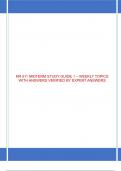
-
NR 511 MIDTERM STUDY GUIDE 1 – WEEKLY TOPICS WITH ANSWERS VERIFIED BY EXPERT ANSWERS
- Exam (elaborations) • 30 pages • 2023
-
- $14.99
- + learn more
NR 511 MIDTERM STUDY GUIDE 1 – WEEKLY TOPICS WITH ANSWERS VERIFIED BY EXPERT ANSWERS NR 511 MIDTERM STUDY GUIDE 1 – WEEKLY TOPICS WITH ANSWERS Week 1 1. Define diagnostic reasoning 2. Discuss and identify subjective & objective data 3. Discuss and identify the components of the HPI 4. Describe the differences between medical billing and medical coding 5. Compare and contrast the 2 coding classification systems that are currently used in the US healthcare system ...
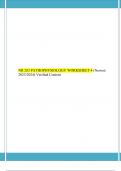
-
NR 283 PATHOPHYSIOLOGY WORKSHEET 4 (Newest 2023/2024) Verified Content
- Exam (elaborations) • 24 pages • 2023
-
- $17.49
- + learn more
NR 283 PATHOPHYSIOLOGY WORKSHEET 4 (Newest 2023/2024) Verified Content Worksheet 4 NR 283 PATHOPHYSIOLOGY WORKSHEET 4 (Newest 2023/2024) Verified Content 1. Define pathophysiology. - involves the study of functional or physiologic changes in the body that result from disease processes 2. Define homeostasis. - a relatively stable or constant environment in the body, including blood pressure, temperature, and pH, maintained by the various control mechanisms ...
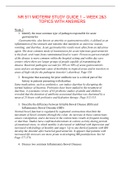
-
NR 511 MIDTERM STUDY GUIDE 1 – WEEK 2&3 TOPICS WITH ANSWERS
- Exam (elaborations) • 28 pages • 2023
-
- $14.99
- + learn more
NR 511 MIDTERM STUDY GUIDE 1 – WEEK 2&3 TOPICS WITH ANSWERS Week 2 1. Identify the most common type of pathogen responsible for acute gastroenteritis Gastroenteritis, also known as enteritis or gastroenterocolitis, is defined as an inflammation of the stomach and intestine that manifests as anorexia, nausea, vomiting, and diarrhea. Acute gastroenteritis results most often from an infectious agent. The most common mode of transmission for acute infectious gastroenteritis is the fecal...
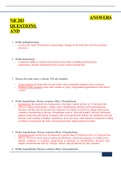
-
NR 283 QUESTIONS AND ANSWERS
- Exam (elaborations) • 23 pages • 2022
-
- $11.49
- + learn more
NR 283 QUESTIONS AND ANSWERS 1 Define pathophysiology. - involves the study of functional or physiologic changes in the body that result from disease processes 2 Define homeostasis. - a relatively stable or constant environment in the body, including blood pressure, temperature, and pH, maintained by the various control mechanisms 3 Discuss the terms acute vs chronic. Provide examples. - Acute rejection develops after several weeks when unmatched antigens cause a...
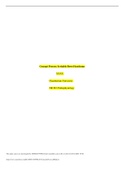
-
NR-283 Week 5 Concept Process Assignment Guidelines #2: Irritable Bowel Syndrome
- Case • 5 pages • 2022
-
- $10.99
- + learn more
Concept Process: Irritable Bowel Syndrome XXXX Chamberlain University NR 283: Pathophysiology Concept Process: Irritable Bowel Syndrome Irritable Bow el Syndrome (IBS) is a “gastrointestinal disorder with manifestations of abdominal pain/discomfort and changes in normal bowel habits (Hubert and VanMeter, 2017)”. The pathophysiology is “the rapid transit time of feces through the bowel. This causes hypersensitivity on the enteric system (Hubert and VanMeter, 2017)”. The basic concept of I...
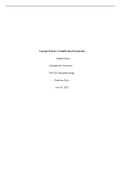
-
NR 283 Week 5 Concept Process Assignment; Irritable Bowel Syndrome
- Other • 4 pages • 2021
- Available in package deal
-
- $10.49
- + learn more
NR 283 Week 5 Concept Process Assignment; Irritable Bowel Syndrome
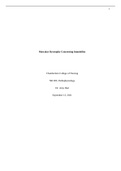
-
NR 283 Week 5 Concept Process Assignment # 2; Muscular Dystrophy Concerning Immobility
- Other • 3 pages • 2021
- Available in package deal
-
- $15.49
- + learn more
NR 283 Week 5 Concept Process Assignment # 2; Muscular Dystrophy Concerning Immobility
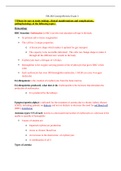
-
NR 283 Week 3 Examination 1 (Concepts to Review)
- Other • 41 pages • 2022
- Available in package deal
-
- $10.99
- + learn more
NR 283 Concept Review Exam 3 **Please be sure to study etiology, clinical manifestations and complications, pathophysiology of the following topics: Hematology RBC-function- Erythrocytes (or RBC’ s) are the most abundant cell type in the body • Its primary job is tissue oxygenation • The cell has 2 unique properties: o A biconcave shape which makes it optimal for gas transport o The capacity to be reversible deformed. The cells can change shape to make it through all the different size ves...
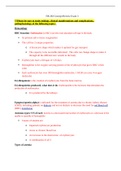
-
NR 283 Concept Review Exam 3 patho (Best for Revision)
- Other • 41 pages • 2022
-
- $10.99
- + learn more
NR 283 Concept Review Exam 3 **Please be sure to study etiology, clinical manifestations and complications, pathophysiology of the following topics: Hematology RBC-function- Erythrocytes (or RBC’ s) are the most abundant cell type in the body • Its primary job is tissue oxygenation • The cell has 2 unique properties: o A biconcave shape which makes it optimal for gas transport o The capacity to be reversible deformed. The cells can change shape to make it through all the different size ves...

Do you wonder why so many students wear nice clothes, have money to spare and enjoy tons of free time? Well, they sell on Stuvia! Imagine your study notes being downloaded a dozen times for $15 each. Every. Single. Day. Discover all about earning on Stuvia


